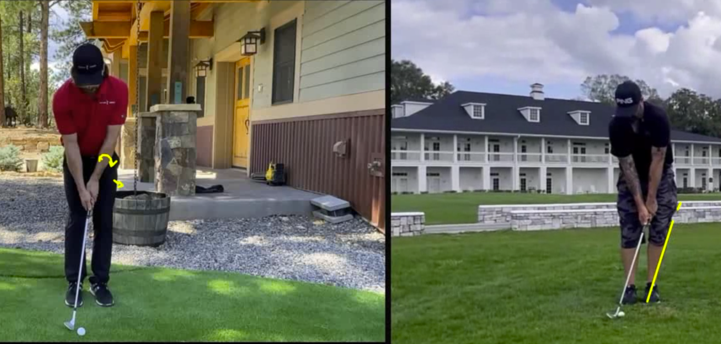Once you've worked through all the videos, in the downswing section, the final step in graduating from the RST program is mastering the release of the golf club. Everything we do in the swing is built around this one split second in time that determines whether you hit a perfect shot...or one out of bounds.
The proper release of the golf club is something that should be learned in a very exact sequence in order to be learned properly and quickly, and this video walks you through that sequence step by step.
"Another day of release drills and I've found more control and coordination. Amazed how far the ball goes and the clean contact with a perfect release. For years I thought release just meant rolling the wrists and forearms, but my left wrist cupped and my left arm bent. The Rotary Swing progressive release drills really helped me understand the process."
-Mike M. | May 3, 2012
The proper release of the club is a beautiful thing to watch. It's this perfectly timed and executed move that makes the tour pros' swings appear so effortless.
In fact, it is this release of the club that allows the club head to not only accelerate at great speed with minimal effort but also delofts and squares the face through impact.
In this video, I walk you through a very specific sequence that allows you to learn the perfect club release in a step-by-step fashion:
- I first teach you how to release the left hand correctly, then
- I'll show you how to FINALLY get your hands ahead of the ball at impact, and lastly
- Work you through the sequencing of slowly reintroducing the right hand so it can do its job in the release.
Once you master the release by working through this sequence, you will hit the ball farther than you ever have before with less effort than you imagined possible.
This should start to help you picture the improvement you can expect...
"I have played golf since I was 6 years old and have deeply ingrained flaws, especially flipping the the club before impact.
The drills we did yesterday were awesome to correct a 50 year old swing flaw!
I am sure all club casters like me will benefit greatly from your new video on the Perfect Release."
-Rick S. | 11/8/2011
As you walk through this video, you can get results like Rick, but there is a very specific sequence in which the drills must be done...
Video Transcription: 5 Minutes to the Perfect Release
In the Lose the Right Hand Drill, I started talking about how you get a speedy release of the golf club without you having to put any effort into it whatsoever.
For a lot of golfers, releasing the club is a foreign concept; they've never actually released the club. They use their body. The problem with that is that your body just keeps turning through impact. The club head and your body have to move at a more relative constant speed together, versus letting my body stop, and the club can move very fast and my body doesn't have to do anything.
In fact, the club can actually release faster - as my body slows down, I transmit energy up the chain into the club. Learning how to release the club, and let that right hand come off, is really important but obviously we don't play golf left handed, although I have a lot of students who ask me if they can, after they work through these drills that you're about to learn now.
What I'm going to do is work through the sequence of how to learn to release the club, very, very slowly, until you start building the proper movements in there.
Here's what I do with all my students. The first thing, when they're learning how to release this left hand, is we take the right hand completely out of the equation. If you're someone who pushes really hard from the right side or flips that right hand, this is critical. Do not skip this step.
You want to start learning how to release the club properly, to get into a proper impact position, so at first what I do is just make sure they can get into a perfect impact position with their left hand only. We'll typically take some variables out of the swing.
I will let them go ahead and stay into their left side impact position, because these are going to be really short swings. We're not going to have a lot of time to shift over, so we'll preset ourselves on our left side.
Then what I'm going to have them do is go back and start coming down and stopping at impact. Obviously this is a hard floor so the club can't stick in the ground, but I generally will have them stick the club in the ground and try and stop right at impact.
These shots are obviously going to be five-yard shots. They're not going to go anywhere. What I'm checking to see is if they can keep that left wrist flat and get into a proper impact alignment with the left side.
Once they can do that, start working on releasing it.
Now what I'm doing is I'm training the left hand to rotate. This is how you release the club. You don't release the club like this. That's what most golfers do. Technically that is a release, but it's not going to go in the right way because what that's going to do is add loft to the club through impact, and now we're trying to time a flip.
You want to think of the release being rotation. There's a lot of force, a lot of speed, a lot of momentum in that club. You have to release that energy somehow, somewhere, and you basically have three options. You can flip it, you can turn your body, or you can just let it release with the left hand.
One's way more efficient than the other, and one allows us to trap the ball and hit the ball in a proper trajectory with a lot of distance. The other one is going to flip it up to the sky, and this one requires a tremendous amount of physical effort. It puts a lot of stress on your spine, on your hip. It's totally unnecessary and it's not nearly as fast as me just doing this.
Why wouldn't you just go for the most efficient way of learning how to release the left hand? Once you can get into a proper impact position, we start working on rotation. From this angle, what you'll see is that my left wrist is still in that arched position I had at impact, and I'm just turning it over.
This is important - to learn where this release happens, or feels like it happens, in the downswing. The target for your left hand in this release is the back of your left thigh, and then what it feels like at that point is it just starts turning over.
Obviously, your wrist is actually gradually rotating throughout the entire downswing, but during the release where we want that snap of speed, it's going to feel like your hand stops at your thigh and turns over.
That's not what happens at all, but for most golfers they need to feel that because they'll either A, move their hand too far forward, and now the logo of my glove is facing down the target line and hasn't released - I've added loft. I want to take loft off the whole time in the downswing, so I've got to feel that my hand stops here, and just turns over.
In reality, because the club is moving and pulling my hands with a lot of centrifugal force, my hands are actually going to release out here, but my feeling is that I'm releasing it more at my thigh in order to get the club to release properly.
Also, when you're hitting short shots it has to feel like it releases here, because your hands aren't going to end up way out here. You don't want to be doing this drill like this. That's not the point of it. It's to get here and release, and turn that club face over.
Now what I'm going to check is that the wrist is still flat. To many it will feel that it exaggeratedly flipped over. You won't do that when you keep your right hand on. That's OK if you're used to scooping it, to have it feeling like the logo of your glove faces the ground.
In an ideal world, it's basically going to face straight back behind you. The toe is going to be in an up position, or slightly shut, which is perfectly OK. We just don't want it cupped.
Once you can do that correctly, we're going to start adding the right hand back in, but we're going to let it come off the club. We've got two drills so far. Start out left hand only, stick it in the ground, just hit these little tiny dribblers and just make sure your impact alignments are correct. Next piece, rotate and release. The ball's going to go a little bit farther, just working on the release.
Now what we're going to do is bring the right hand in there to add some speed to it. Same thing, back, but I want you to let the hand come off through impact.
Now the right hand is going to add a little bit more speed. Notice each time I add a piece to the drill, the club's moving a little bit faster. It's a little bit more challenging for me to maintain these positions if they're not something I'm comfortable with or used to.
At first this was really slow. Then as we added the release it got a little faster. Now with the right hand in there, I can add a little bit of speed to it. The key is, I still want you to let go of the club. If you're used to being really right-hand dominant, this will be actually a challenge for you.
Even though this looks really simple, it's because I've done it millions of times. What you're going to find is that a lot of golfers aren't going to want to let go of the club when they're actually hitting balls. It's OK, you've just got to work through this drill slowly. That's the third step.
The fourth step that you're going to do is work on releasing it, but once you let your left hand go I want you to bring your right hand up into position. Don't move your body. My left hand's fully released. Notice that my body, my hips and everything, are still square. During this drill, my body's not moving.
Everything we've worked on in these other drills, keeping your belt buckle and your buttons on your shirt square at impact, is still the same. Now, even though my left hand's released, my body is still square. Now I'm going to bring my right hand up into that position, slowly but surely.
Now you can see that my body has actually been forced to turn because, as my right hand comes across to grab the club, my shoulders have to turn slightly. What this drill is going to do is teach you what you should feel like in your follow through, once the right hand's back on there.
Now we're starting to put the whole thing together and maintain our positions. What's going to be hard for you is when you start doing this in your swing, to not want to reach across and grab the club. Now I've lost my axis tilt, I've moved my shoulders too far across.
It should feel like that left arm is wide, and you're just reaching across and under to grab it with the right hand, and now we're in a good follow through position. That's the fourth step. Release, bring the right hand up just barely touching the club.
Once you can get through those pieces, now we're ready to keep the right hand on the club. Just like I talked about in the Lose the Right Hand Drill, you're going to feel like your hand is just a passenger. Your right hand, from down the line, is going to look like it's almost coming off the club at first.
You want that club to be able to release freely, the right hand just barely touching the club, and you're controlling it and releasing it with the left hand. That's the critical piece.
Then you can stack this last piece on; full release, but your right hand is just barely touching the club. That's what your regular golf swing should feel like. You don't have to completely let go of it like Vijay does - although you'd release it faster if you did. You just want your hand to be light on the club.
Work through this, five minutes a day. Just come through, get into an impact position, release position, right hand adding speed, right hand releasing coming back into the follow through, and then put them all together.
You can work through them in that sequence. If you can do this correctly, once you master each piece individually...the first time you do this for five minutes a day you might only do just left hand, until this is perfect. If this starts cupping and your hands are behind the club head and all those things, there's no point in working on the release until you get impact correctly.
Work through each piece, and then as you get comfortable start stacking it into a drill, just like you see here, until your whole golf swing starts to feel like what your drill is.
Work on this 5 Minutes to the Perfect Release Drill, and you'll be able to get a lot of speed. You'll be able to control the club face, you'll put no effort into your golf swing, and you'll start to enjoy the game a lot more as you start to compress the ball and hit it farther than you ever have.
Watch part 2 now to see how you're moving your body in the opposite direction of the pros!






























































































































































































































